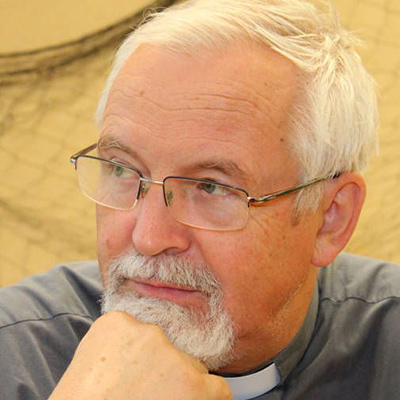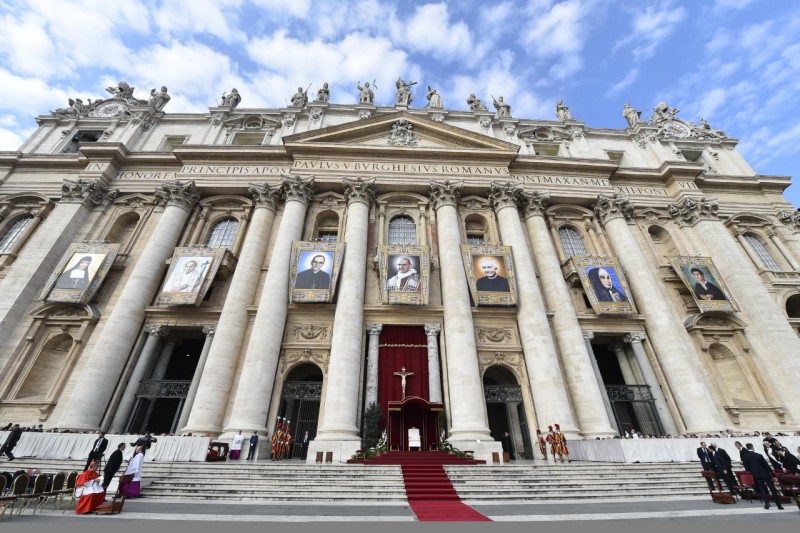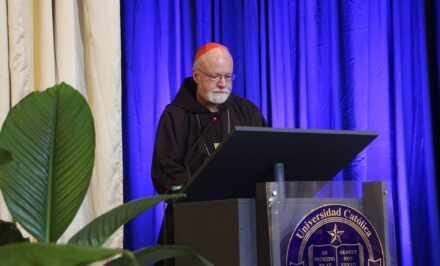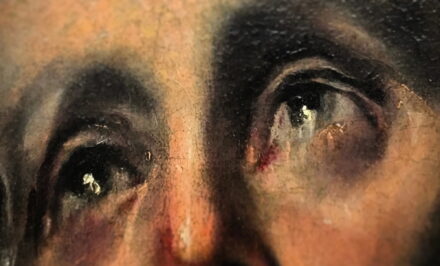Sexual abuse – what now? Elmar Busse, Schoenstatt Father •
“For the last thirty years, and not just since the Cox case, I have known anger and shame well up in me on account of colleagues who had destroyed in minutes what I have been unable to heal in many hours over many years with the people concerned.” –

Fr Elmar Busse, born 1951 in Heiligenstadt, and ordained a priest in 1980, has worked as a pastor to youth and families, and for the last few years has led the spirituality department in the Katharina Kasper Academy run by the Poor Handmaids of Jesus Christ in Dernbach, Germany.
He has worked for years with victims of sexual abuse, and he has been deeply touched by the coincidence of a well-known Schoenstatt Father and former bishop belonging to the founder generation of Fathers in Chile being laicised, and the brilliant canonisation of people like Oscar Romero, Paul VI and Katharina Kasper. We spoke to Fr Elmar Busse in the framework of our editorial contributions to the subject of abuse, which has deeply affected Schoenstatt as and with the Church – even though some thought till recently the something like that could not happen in Schoenstatt (cf. our contribution: “Like the Church we are, we also carry grace in stone jars.”) Fr Busse answered our question: “Abuse and the laicisation of Francisco Jose Cox – What now? “ with remarks that give much food for thought.
Contrapuntal compositions
For Johann Sebastian Bach, the composer, contrapuntal composition was a major characteristic of his musical style. Two contrasting melodies are interwoven, but they end in harmony. Parallel thirds were frowned upon – at least with regard to the main voices. In theory and practice the composers, Palestrina and Johann Joseph Fux, contributed much towards popularising this style of composition. When God, with and despite the freedom of human beings, composes his salvation history, it seems that he has a special love for counterpoint. The coincidence of the laicisation of the Archbishop Emeritus of La Serena and Schoenstatt Father, Franz Josef Cox on 13 October, and the canonisation of Katharina Kasper, the only German this year, on 14 October, are extremes that spell out that the Church is always a community of saints and sinners.
Theologians even use the drastic expression: “Holy Whore”.
On the one hand, as Germans we can be proud of Katharina Kasper. She is one of us. On the other hand, we Fathers are ashamed, because Bishop Cox is one of us.
Canonisation: “Tested safety”
I take the liberty to fill in some background considerations.
When you look underneath or behind your coffee machine or microwave, you will find the GS tested safety mark. This label is regulated by law and stands for tested safety. It is accepted worldwide. The manufacturer shows the customer that the product has been tested by a state-approved inspection authority. Many manufacturers have changed from using the GS to the CE mark, which certifies a far wider range of products including toys, medical equipment, etc. Canonisation is a similar seal of approval. The “Quality Control Office” in Rome confirms: “As a follower of Christ you can take your bearings from the sayings and behaviour of Katharina Kasper without reservation. They will do no harm – on the contrary, you will be inspired to be a better person and Christian.”
It may sound natural, but it isn’t. There are many charlatans, gurus and seducers in the field of religion and spirituality, and they manage to attract enthusiastic followers, partly with disastrous consequences. We need only think of religiously motivated suicide bombers, of the Aum sect whose members carried out the poison gas attack on the Tokyo metro on 20 March 1995, or the collective suicide of the Branch Davidian sect in Texas in 1993 when 86 people died. The double life of the founder of the Legionaries of Christ, Marcial Maciel, could also be included in this field.
What is structurally dangerous in the messages of such people who have charismatically attractive personalities is that they evade rational arguments. Their crazy ideas and prophesies of the end of the world may seem totally abstruse, but their doting followers allow themselves to be infected by these crazy ideas and are led astray.
For people with charismatically attractive personalities it is doubly important to cultivate reverence for the personality and freedom of others, because enthusiastic followers give charismatic leaders so much trust and love that they become vulnerable. The temptation to abuse this trust immediately suggests itself.
Observe fire safety rules
Fr Kentenich anchored “fire safety rules” in his communities. The most important of these is to be “inwardly spontaneous – outwardly untouched”. That is to say, with regard to physical closeness pastors should not go beyond the customary forms of greeting and politeness.
Despite being admonished a number of times, Archbishop Cod did not keep to this rule. After the first notification in this regard reached the leaders of the Schoenstatt Fathers over twenty years ago, Fr Cox was removed from pastoral work as a preventative measure and given administrative tasks. At the time it was a purely preventative measure. No accusations had been made, as is happening today.
It takes decades to change a social idea
Let us recall the social climate in Germany at the time when the community leaders took the preventative measures:
In 1980 the Green Party decided in their first party manifesto to largely legalise consensual sexual relations between adults and children and wards. “Consensual” played a great role at that time, however it does not in fact exist. How can children object? In the early 1980s the Green Party in the German states of Rheinland-Palatinate, Bremen, Hamburg and Berlin represented the demands of some homosexual groups and paedophile associations to repeal §174 and 176 of the penal code. A change of mind only happened after 1985 following Party research. As a result of the influence of feminists like Alice Schwarzer, as well as the homosexual lobby distancing itself from the paedophile scene, the decisions retreated into the background. The demand for the legalisation of paedophilia was only formally abolished in 1993 when the Green Party amalgamated with the East German “Buendnis 90”. In 1980 the FDP Party’s youth organisation of German Young Democrats also voted to de-criminalise sexual relations between adults and children or wards.
Such aberrations never happened in Church circles.
However, in view of the sensitivity that has evolved today, and the changed mentality, we have to call to mind very consciously that in such a climate sexual assaults were trivialised by many groups.
A symptom of such trivialisation in the climate at that time is the lack of action on the part of the Ministry of Education and the public prosecutors in Darmstadt in 1999 when the first accusations against Gerold Becker, the Principal of the Odenwald School, were raised. Not even the press took up the scandal.
Also this is the Church: People who care for the victims of abuse
Pastors who for years have cared for the victims of abuse, and who know all about the protracted processes of healing, are also people of the Church.
I can well remember how at that time in Vienna a 70-year-old I had accompanied for some years remarked, “I am totally surprised that I have even been able to trust a priest again.”
For the last thirty years, and not just since the Cox case, I have known anger and shame well up in me on account of colleagues who had destroyed in minutes what I have been unable to heal in many hours over many years with the people concerned.
However, there are also signs of hope. A few years ago I received a woman back into the Church who had been sexually abused by her father and her elder brother. The only possible reaction for her at the time was to leave the Church when she was fourteen, because her father was known and honoured in the parish as a committed Catholic. It is obviously not possible to talk about healing, and her contact with her father and brother has been put on hold, but this woman, who has in the meantime grown into adulthood, has been reconciled with the Church.

The Church marked by light and shadow
The canonisation on 14 October not only of Katharina Kasper (1820-1998), but also of Pope Paul VI (1897-1978), Archbishop Oscar Romero (1917-1980), and another four Catholics, indicates that there have always been saints and sinners in the Church. St Vincent de Paul, for example, was a contemporary of the power-hungry and scheming Cardinal Richelieu.
When we look at Katharina Kasper, her behaviour and what she wrote, we will notice that she was not ensnared by the stereotyping common at that time. Her Sisters were to care for the suffering, no matter whether they were Catholics, Evangelical, Jewish or atheists. By the way, there is no world religion that so consistently makes love of one’s neighbour the yardstick for the genuineness of love of God as Christianity. “What you have done to the least, you have done to me.” These words of Jesus are certainly the most effective words for making the world a more humane place.
Secondly, Katharina, who had only attended primary school for eight years, set great store by the education and further training of her Sisters. She wanted to form people who were inwardly free, who could stand on their own two feet and who gladly took the initiative. With her we find no sign of a forceful education to humility, which only generates spiritual cripples – which at the time was deplorably the case in religious communities.
The fact that the “quality control commission” in the Vatican has given its seal of approval to this original way of imitating Christ, and even called it an example to be followed, does us good at this stage when there is a crisis of trust in the Church.
Original: German. Translation: Mary Cole, Manchester, England














